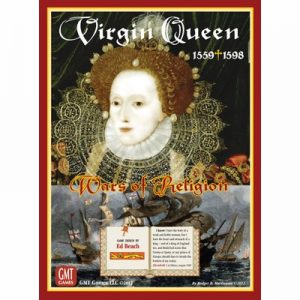Beschrijving
Min leeftijd: +13
Aantal spelers 2
Gem speelduur 180 min
De Patriotten van Lower Canada werden berucht vanwege de opstanden in 1837-1838 die aanleiding gaven tot een bloedig optreden van de koloniale autoriteiten. De veldslagen die het gevolg waren van dit escalerende geweld hebben een behoorlijke stempel gedrukt op de verbeeldingskracht en de geschiedenis van een moderne natie die niet gewend is aan gewapende conflicten op haar grondgebied.
Maar de meeste inwoners van Quebec weten tegenwoordig weinig over wat tot deze gebeurtenissen heeft geleid. In de jaren vóór de opstand vormden de eisen voor meer macht voor gekozen functionarissen en voor erkenning van de rechten van de Canadezen de kern van een ideologische strijd tussen de Patriotten en een coalitie die loyaal was aan het systeem dat onder de Britse kroon bestond.
“Prelude to Rebellion” beeldt dit ideeënconflict af als een kaartgestuurd spel waarbij gebruik wordt gemaakt van belangrijke gebeurtenissen uit de periode 1834 tot 1837. Bij typisch CDG-handbeheer wordt u heen en weer geslingerd tussen het gebruik van de activiteitspunten of gebeurtenis van elke kaart, terwijl u uw best doet om uw kaarten onschadelijk te maken. kaarten van de tegenstander. De essentie van het spel is dat je ernaar streeft de mensen uit de verschillende provincies van Lower Canada te mobiliseren en hen achter jouw standpunt te brengen. Naast Montréal en Québec (beschouwd als stedelijke provincies) zijn 24 landelijke provincies, elk gericht op een factie, op het bord vertegenwoordigd. Elke provincie beschikt over een aantal mobilisatieboxen, die elk een aantal activiteitspunten kosten om er een blokje in te plaatsen. Van degene die de meeste kubussen in een provincie heeft, wordt gezegd dat hij deze beheert.
Nadat je voldoende draagvlak in een provincie hebt opgebouwd, probeer je daarin organisaties (een groep leiders) te creëren. Hoe meer blokjes in de provincie en hoe meer activiteitspunten je aan deze actie besteedt, hoe groter je kans op succes. Met een vast aantal kanspunten per beurt kun je de grillen van de dobbelstenen verzachten, maar kun je ook nuttige evenementen kopen uit de ‘Opportunity pool’, waar aan het begin een paar kaarten en belangrijke gebeurtenissen van het conflict worden geplaatst van elke beurt. Geef te veel punten uit om een dobbelsteenworp te ‘scheren’ en het is mogelijk dat u geen nuttige kaart uit de voorraad kunt kopen. Als u al uw punten besteedt aan het kopen van kaarten, zullen uw volgende dobbelstenenworpen des te stressvoller zijn.
De controle van stedelijke provincies, controle van landelijke provincies, organisaties en externe invloed (hoe verschillende omringende machten zoals Groot-Brittannië, Frankrijk, de VS, enz. zich in het conflict mengen) vertegenwoordigen de belangrijkste bron van overwinningspunten. Wie de overhand heeft op deze vier kwesties, wordt verantwoord op een zogenaamd scorespoor. Elke keer dat een kaart wordt gespeeld, wordt er een scoredobbelsteen gegooid. Welk gezicht er ook verschijnt, het bijbehorende scorespoor komt dichter bij het toekennen van een proportionele OP-lading aan de speler die er voor staat. Timing is alles, want de scoredobbelstenen zullen je voortdurend dwingen je strategie aan te passen. Houd er rekening mee dat dit mechanisme niet volledig willekeurig is, omdat elke dobbelsteen een grotere kans heeft om een specifiek traject vooruit te gaan, zodat bekwame spelers altijd als winnaar uit de bus komen.
De scoresporen staan op het bord, zodat beide spelers ze kunnen zien. Hoewel elk spoor in theorie één keer per beurt scoort, kan het spoor van de landelijke provincies in de praktijk misschien twee keer scoren, terwijl het spoor van de organisatie op de een of andere manier vastloopt voor verschillende cruciale actierondes. Je kunt het lot echter niet voor altijd bedriegen, omdat bij elk kaartspel de worp van een scoredobbelsteen wordt geactiveerd. Je zult spannende momenten ervaren wanneer alle nummers op het punt staan te scoren, maar ook momenten van rust wanneer alle nummers net hebben gescoord en er een kans is om te proberen je positie op sommige punten te verbeteren.
Dit is geen oorlogsspel: het spel eindigt wanneer het gevecht begint! Eigenlijk moeten beide partijen zich voorbereiden op een oorlog die misschien wel nooit zal uitbreken. De track ‘Rebellious spirit’ meet hoe dichtbij het uit de hand dreigt te lopen. Hoe hoger het wordt, hoe lelijker en gewelddadiger het conflict wordt. Net als in het echte leven kunnen de Patriotten geen tijd meer hebben als enkele heethoofdige leiders de kolonie in een directe confrontatie met het Britse leger storten. De mensen zijn het beu en de klok tikt: als de resultaten uitblijven, kunnen de Lower Canadezen in de verleiding komen om de wapens op te nemen, als ze zien hoe succesvol hun zuiderburen vijftig jaar geleden waren!
Je hebt meer dan jouw deel van de oorlog gesimuleerd. Speel nu uit wat daartoe leidt!
The Patriotes of Lower Canada became notorious for uprisings in 1837-1838 that prompted a bloody crackdown by the colonial authority. The battles that resulted from this escalating violence left quite a mark on the imagination and history of a modern-day nation unused to armed conflict on its soil.
But most Quebecers today know little about what led to these events. In the years before the rebellion, the demands for greater power for elected officials and for recognition of the Canadians’ rights were at the heart of an ideological struggle between the Patriotes and a coalition loyal to the system in place under the British crown.
“Prelude to Rebellion” depicts this conflict of ideas as a card-driven game using key events from 1834 to 1837. In CDG-typical hand management, you will be torn between using each card’s activity points or event while doing your best to defuse your opponent’s cards. The gist of the game is that you will strive to mobilize the people of the various counties of Lower Canada and rally them to your point of view. In addition to Montréal and Québec (considered urban counties), 24 rural counties, each biased towards a faction, are represented on the board. Every county has a number of mobilization boxes, each costing a number of activity points to put a cube in it. Whoever has the most cubes in a county is said to control it.
After building up a sufficient amount of support in a county, you will try to create organizations (a grouping of leaders) in them. The more cubes in the county and the more activity points you dedicate to this action, the greater your chance of success. A fixed amount of opportunity points per turn allow you to mitigate the whims of the dice but also allow you to purchase helpful events from the ‘Opportunity pool’, where a few cards as well as key events of the conflict are put into at the start of every turn. Spend too many points to ‘shave’ a die roll and you might not be able to purchase a helpful card from the pool. Likewise, spend all your points to purchase cards and your next die rolls will be all the more stressful.
Urban counties control, rural counties control, organizations and external influence (how various surrounding powers such as Britain, France, the US, etc. are meddling in the conflict) represent the main source of victory points. Whoever has the upper hand for these four issues is accounted for on what’s called a scoring track. Every time a card is played, a scoring die will be rolled. Whichever face turns up gets the associated scoring track closer to granting a proportional VP payload to the player ahead on it. Timing is everything as the scoring dice will constantly force you to adapt your strategy. Note that this mechanic is not completely random as each die has a greater chance to advance a specific track so skillful players will always come out on top.
The scoring tracks are right there on the board for both players to see. While each track will score in theory once a turn, in practice, the rural counties track might score twice while the organizations one will somehow get stuck for several crucial action rounds. You can’t cheat fate forever though as each and every card play will trigger the roll of a scoring die. You will experience tense moments when all tracks are on the verge of scoring as well as moments of respite when all tracks just scored and there is a window of opportunity for you to try to improve your position on some issues.
This is not a wargame: the game ends when the fighting begins! Actually, both sides need to prepare for a war which might in fact never break out. The ‘Rebellious spirit’ track measures how close things are to get out of hand. The higher it gets, the more ugly and violent the conflict becomes. Just like in real life, the Patriotes might run out of time as some hot-headed leaders plunge the colony into a direct confrontation with the British army. People are fed up and the clock is ticking: if results don’t start showing up, Lower Canadians might be tempted to take up arms, seeing how successful their Southern neighbors were 50 years before!
You’ve simulated more than your share of war. Now, play out what leads to it!








